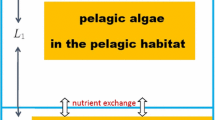Abstract
A differential equation model is proposed for “brown tide” algae blooms in the coastal waters of Long Island which provides a plausible mechanisms for the underlying dynamics. Growth rates depend on annual variations in temperature and salinity. The maximum population density is effectively limited by the availability of a favorable concentration of nutrients, together with zooplankton grazing. Salinity depends on rainfall while nutrient concentration is influenced by tidal flushing. The first of these factors is aperiodic, the second periodic, in time. The resulting nonlinear model distinguishes between ‘fast’ algae growth and ‘slow’ long-term changes in nutrients and salinity. Because of this one can show that explosive increases of algae densities will occur infrenquently at sporadic intervals. Computer trials with the model appear to replicate many, if not all, the essential features of the observed bloom.
Similar content being viewed by others
Literature Cited
Beltrami, E.. 1987. Mathematics for Dynamic Modeling. Academic Press, New York.
Bruno, S., R. Staker, G. Sharma, andJ. Turner. 1983. Primary productivity and phytoplankton size fraction dominance in a temperate North Atlantic estuary.Estuaries 6:200–211.
Cosper, E., W. Dennison, E. Carpenter, M. Bricelj, J. Mitchell, S. Kuenstuer, D. Coleflesh, andM. Dewey. 1987. Recurrent and persistent “brown tide” blooms perturb coastal marine ecosystem.Estuaries 10:284–290.
Eppley, R.. 1971. Temperature and phytoplankton growth in the sea.Estuaries Bull. 70:200–211.
Hardy, C.. 1976. A preliminary description of the Peconic Bay estuary. Mar. Sci. Res. Rep 3, State Univ. New York, Stony Brook, New York.
Lively, J., Z. Kaufman, andE. Carpenter. 1983. Phytoplankton ecology of a barrier island estuary: Great South Bay, New York.Estuarine Coastal Shelf Sci. 16:51–68.
Ludwig, D., D. Jones, andC. Holling. 1978. Qualitative analysis of insect outbreak systems: The spruce budworm and forest.J. Animal Ecol. 47:315–332.
Steele, J., andE. Henderson. 1981. A simple plankton model.Amer. Nat. 117:676–691.
Author information
Authors and Affiliations
Rights and permissions
About this article
Cite this article
Beltrami, E. A mathematical model of the brown tide. Estuaries 12, 13–17 (1989). https://doi.org/10.2307/1351445
Received:
Accepted:
Issue Date:
DOI: https://doi.org/10.2307/1351445




